The Japanese Navy established its own Naval Aeronautics Research Association in 1912. It developed an interest in airships during World War 1, especially after witnessing the effectiveness of German Zeppelins in naval battles.
It received one Zeppelin dirigible as part of German World War 1 reparations. This was one of their naval ‘super zeppelin class’ L37 (LZ 75). However, the Japanese were not interested in taking airship technology further at that time. Although they did retain a few engines, gas valves and instruments for study before breaking up the airship.
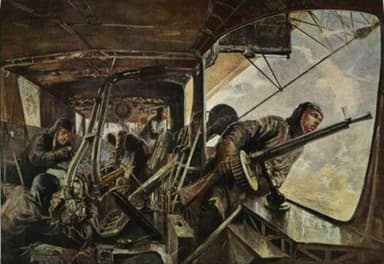
https://en.wikipedia.org/wiki/Zeppelin#/media/File:Maschinengondel_eines_Zeppelin-Luftschiffes_-_Felix_Schwormst%C3%A4dt_1917.jpg
The airship had failed to be the invincible fighting machine Count von Zeppelin dreamed of in the First World War. He died in 1917, after which his heirs kept refining the same thing over and over. Who knows what might have happened if he lived on
However, Hugo Eckener – who took over after Count Zeppelin passed on – had a new vision for dirigibles after Germany surrendered. These would be a slightly slimmer design to reduce drag, and have an integral module for command and passenger accommodation.
Passengers would no longer be an appendage. His first masterpiece was Bodensee, the German name for Lake Constance near where the Zeppelin factory stood.
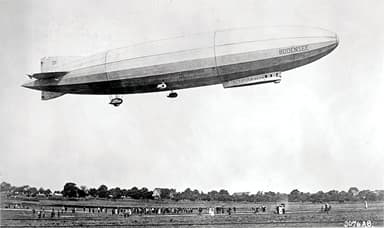
https://en.wikipedia.org/wiki/File:Airship_Bodensee,_Oct._1919.jpg
Passenger facilities included seating for 20 passengers, a separate VIP cabin, and a galley and toilets. In fact, the entire arrangement was reminiscent of a railway carriage. There was also provision for a further 10 passengers in wicker chairs between compartments. LZ 120 Bodensee first took to the air in 1919.
She provided a passenger service between Friedrichshafen and Berlin 460 miles apart. The rigid dirigible was 396 ft long with a top speed of 82 mph, and a maximum flight range of 1,100 miles. Her power came from four 260 hp Maybach Mb.IVa engines.
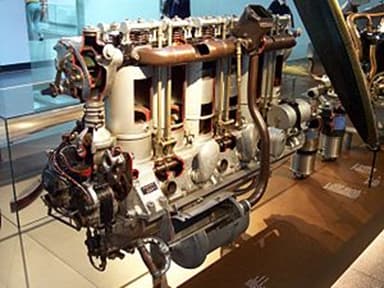
https://en.wikipedia.org/wiki/File:Maybach_Mb_IVa.jpg
Two engines were in the aft gondola, where they drove a single pusher propeller. The other two were affixed on either side of the hull. These drove two-bladed propellers via a reversible gearbox allowing reverse thrust for maneuvering when landing.
Bodensee completed over 100 flights, carrying 2,322 passengers over a total distance of 31,000 miles. This included a seventeen-hour flight between Berlin and Stockholm 680 miles distant. She was modified and lengthened after a partial engine failure in 1919, to make the control surfaces less sensitive.
The Allied Powers confiscated Bodensee and her sister ship LZ 121 Nordstern in 1921 as World War 1 reparations for airships German air crews destroyed at the end of the conflict.. Thereafter, Bodensee and her sister ship Nordstern LZ 121 (meaning Northern Star) operated successfully in Italy and France, until 1928 and 1926 respectively.
Britain and the U.S. Lead in Dirigible Race
British Military Airships in the 1920’s
German airship Zeppelin L33 had come down almost intact in the Yorkshire countryside on September 14, 1916, after being struck by an anti-aircraft shell. The British studied it before cloning two almost identical replicas, R33 and R34. These were highly successful despite being three years out of date when they launched in 1916.

https://en.wikipedia.org/wiki/File:R34.jpg
The R33 class were perhaps Britain’s most successful rigid airships. R33 provided 10 years of service. She was demilitarized after the first two years, and deployed for airship research including launching and recovering a De Havilland 53 Hummingbird aircraft. She proved remarkably robust during several near-disasters. However, severe metal fatigue caught up with her and she was broken up in 1928.
R34 flew across the Atlantic in 1919 in 108 hours, having almost run out of fuel. A passenger, Major E. M. Pritchard had to parachute down to assist with the landing, becoming the first person to fly from Europe to America.
The return journey a week later took just 75 hours, arguably because of better weather conditions. However, this achievement failed to attract sufficient support, and the British abandoned their transatlantic program. R34 suffered severe damage during a 1921 storm, and was written off and scrapped.
The Imperial Russian military had used its small airship fleet for wartime reconnaissance and bombing missions. That’s because they carried larger bombing loads, and had greater range compared to airplanes. However, they failed to attract interest during the early Soviet period.
But from 1920 onwards there was fresh interest from the new government. The details available are few, however we do know Russia built a series of airships designated CCCP-B* from 1920 through to 1947.
These were most likely non-rigid blimp-type vessels at least in the beginning, despite ambitious five year plans promising rigid zeppelin-styled airships.

Japan Enters the Military Airship Arena
Japan imported a hydrogen airship from Britain in 1921. This was a Vickers SS 3 Sea Scout type, rushed into production to counter German U-boat threats to British shipping in World War 1. The small, blimp-type Vickers airship was 171 feet long, with a maximum diameter of 36 ft, and 100,000 cu ft capacity
Two Rolls-Royce 90hp six cylinder in-line water-cooled engines drove four-bladed pusher propellers outboard, and on either side of the gondola rear. This was streamlined with a five-crew enclosure, and facilities for two machine guns and four 12 pound bombs.
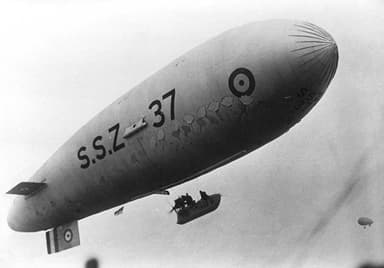
https://en.wikipedia.org/wiki/SSZ_class_airship#/media/File:Airship_SSZ_37.JPG
The Japanese Sea Scout arrived in Japan in early 1922, complete with a mooring mast for assembly at Yokosuka Naval Air Station. Its first, May 22 flight was a success. However, a hydrostatic discharge destroyed it on July 11, 1922 in its makeshift hangar.
Japan followed up with a larger non-rigid Astra-Torres Nieuport AT-2 made in France in 1923. This had twin Sunbeam 300hp twelve cylinder V water-cooled engines, each driving a two bladed tractor propeller mounted outboard of the gondola center.
Weaponry included a machine gun, a cannon, and four 100 or two 200 lb bombs. Britain had deployed the airship for coastal service until May, 1916, where after it switched over to its own cloned versions. It made one flight over Japan before an earthquake damaged the outside plant producing hydrogen gas.
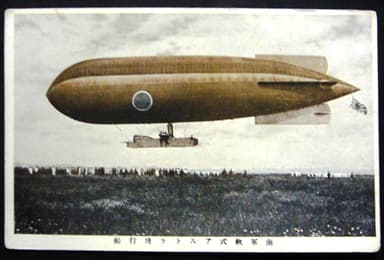
https://www.facebook.com/airshipsbook/posts/i-love-this-photo-imperial-japanese-navy-operated-1922-1924-an-astra-torres-airs/2509492202694895/
The Japanese Navy continued with its fleet expansion plans by building a replica of the fated Sea Scout, but with 100 hp engines in 1923. It made a round trip between Yokosuka to Osaka in June that year, before relocating to Kasumigaura in December 1923.
All we know after that is the Sea Scout replica exploded in mid-air during a flight on March 19, 1924, killing all on board. That might have deterred a less-determined leadership, but the Japanese Navy was determined to continue. It ordered a series of Sea Scout replica airships, which generally performed well.
The Navy decided to explore larger, semi-rigid airships next. It ordered an airship N-3 from Italian Umberto Nobile, manufacturer and polar explorer. This took the Navy to a new level, being 263 ft long with a maximum diameter of 49 ft and a hydrogen capacity of 274,700 cu ft.
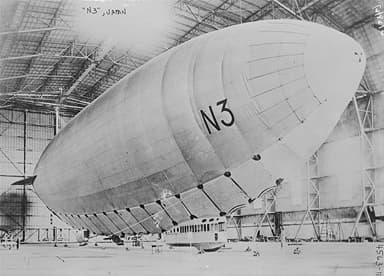
https://en.wikipedia.org/wiki/File:%22N3,%22_Japan_LOC_26775146275.jpg
Twin Maybach, 245hp six cylinder in-line water-cooled engines drove two bladed pusher propellers, mounted in streamlined housings abreast of each other. The glazed, enclosed cabin housed seven-to-twelve crew, who maintained control through horizontal stabilisers and dorsal / ventral rudders.
N3 arrived in Japan in January 1927, and was assembled in the shed being prepared for the 1929 Zeppelin around-the-world flight. Umberto Nobile took her on her first flight on April 6, assisted by a mixed crew. Thereafter, she flew successfully until making an emergency landing on an island. The crew managed to disembark safely, before a gust of wind carried N3 out to sea, where she utterly exploded.
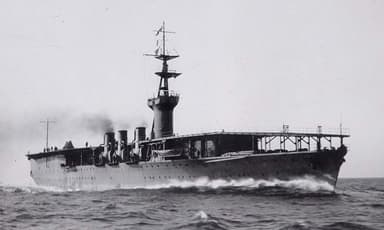
https://en.wikipedia.org/wiki/File:Japanese_aircraft_carrier_Hosho_1922.JPG
By now aircraft carriers were proving more effective in naval maneuvers. It was just a matter of time before Japanese military commanders accepted the writing on the wall.
Umberto’s Nobile’s N3 may have had a short life, although she did claim the role of being Japan’s fastest airship. The navy ordered a replacement, Navy Type 3 from Fujikura and Mitsubishi their traditional suppliers. However, this time the vessel had a stronger keel and more powerful engines.
The giant airship flew only once, between March 14 and 17, 1931, creating a new duration record of just over 10 hours. After that, the Japanese Navy threw in the towel. Airships were too expensive to build, too vulnerable to damage, and of questionable use in operational
U.S. Military Airships in the 1920’s
America had been dabbling with a new airship since 1919, when the Navy Bureau of Aeronautics and Goodyear Tire & Rubber Company completed a new design. However the first J-Class, J-1 only took to the air on August 31, 1922. But the single ballet gas-filled compartment made it difficult to handle and it retired in 1924. Sister ship J-2 was never built.
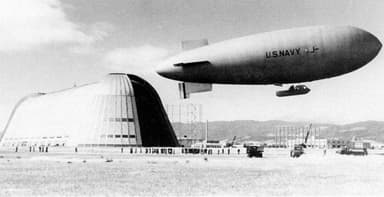
https://en.wikipedia.org/wiki/File:J_class_blimp.jpg
The specification for the J-Class was follows:
- Length 196 ft, diameter 44 ft, height 58 ft, volume 210,000 cub ft, 2 crew
- Propulsion 2 x radial 130 hp motor, max speed 60 mph, cruise speed 46 mph
- Range 970 mi, endurance 52 hrs, service ceiling 8,000 f, useful lift 4,600 lb
Airship J-3 first flew on October 12, 1926 from Lakehurst as a training ship. She was lost on April 4, 1933 with 2 out of 7 crew during a forced landing while searching for survivors of USS Akron. The survivor J-4 served as a trainer for a while before being stored.
America’s Experiment With Rigid Airships
America had also not deterred when the British R38 it had ordered crashed on a test flight on August 23, 1921. It decided to build its own ZR-1 instead, based on Zeppelin LZ 49 forced down intact in France during World War I but to be named USS Shenandoah.
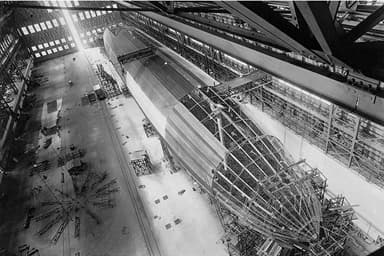
https://en.wikipedia.org/wiki/File:USS_Shenandoah_Bau.jpg
When USS Shenandoah launched on September 24, 1923 with a complement of 25 crew, she contained most of the world’s supply of the lifting gas helium. Her specification was as follows:
- Length 680 ft, weight 36 tons, range 5,000 miles, top speed 69 mph
- Propulsion 6 (later 5) 300 hp eight-cylinder Packard gasoline engines
- Armament 6 × 0.30 in Lewis machine guns, 8× 500 lb bombs
USS Shenandoah had a successful flying career including crossing North America. However, she had an inglorious end when an updraft in a thunderstorm burst her gas bags, and she crashed in several pieces on September 23, 1925.

https://en.wikipedia.org/wiki/USS_Shenandoah_(ZR-1)#/media/File:Uss_Patoka_AO9.jpg
The United States had a second patrol ship ZR-2 undergoing trials when it suffered structural failure and crashed on August 24, 1921 killing 44 of 49 crew members. The third one, ZR-3 named USS Los Angeles was completed by Zeppelin in 1924 as war reparation under the Versailles Treaty.
The government used it primarily as an observatory, and an experimental platform for their parasite program for launching and recovering smaller aircraft from larger flying vehicles. The Los Angeles specification adhered closely to that of German Bodensee, with an integral module for command and passenger accommodation.
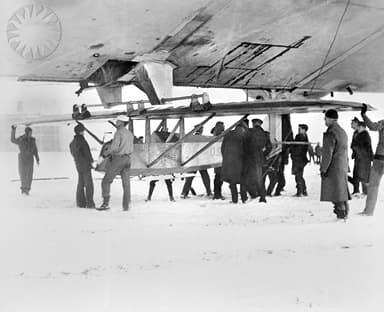
https://en.wikipedia.org/wiki/File:Pr%C3%BCfling_glider_attached_to_USS_Los_Angeles.jpg
USS Los Angeles carried innovative equipment for recovering water from exhaust gases to compensate for weight loss from consumed fuel, and thereby avoid venting scarce helium. She was decommissioned and dismantled in 1939. This earned her the dubious honor of being the only U.S. Navy rigid airship which did not meet a disastrous end.
The U.S. Army experimented with blimps acquired in the immediate postwar period from American, British and French sources. It used them to experiment during observation, surveillance, border patrol, and bombing exercises.

https://en.wikipedia.org/wiki/File:Italian_airship_Roma_over_Norfolk_VA_1922.jpg
The U.S. Army acquired the semi-rigid Italian airship Roma in 1921, and it was the largest the force ever operated. At that time she was also the largest semi-rigid dirigible in the world, and designed for transatlantic crossings.
Roma was 410 ft long, with control and passenger spaces inside a partially articulated keel. Six 400 hp Ansaldos engines boosted her to a relatively low speed of 50 mph, although she had a trade-off flying range of 7000 miles.
The military considered her suitable for fast transport of troops and supplies, and locating hostile fleets far out of sea. Alas Roma, and many of her predecessors and successors met a fiery end. Her box rudder system failed, she collided with high voltage lines as she attempted landing, and 34 crew out of 45 on board perished.
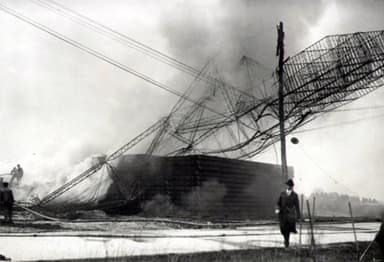
https://en.wikipedia.org/wiki/Roma_(airship)#/media/File:Roma-burning.jpg
The U.S. Congress decreed all US airship operations would in the future use helium gas, instead of flammable hydrogen as lifting medium, leading to a monopoly over the has.
The majority of U.S. Army Air Service airships in the 1920’s were of the T-Class variety, and intended for coastal duty. This was because the US Army had long held primary responsibility for coastal and harbor defense of the USA.
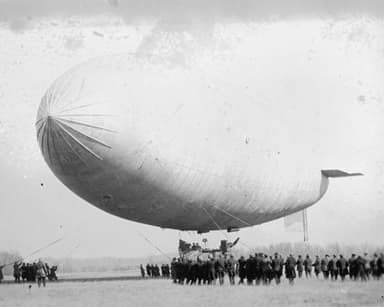
https://en.wikipedia.org/wiki/File:T.C._Army_airship,_3-28-23_LCCN2016847412_(cropped).tif
The Army intended to use them to search out and track hostile ships until they came under fire from coastal defenses or Army bombers. They also conducted numerous trials down the years to see whether blimps could become ‘flying aircraft carriers’ for launching and recovering fixed wing airplanes.
Meanwhile Goodyear Tire and Rubber Company was honing its skills on military blimps. This led to an order from the U.S. Army Air Service for RS-1, the only advanced semi-rigid airship built in America. Fabrication of parts began in 1924 and continued through 1925 with assembly at Scott Field Air Force in Illinois.
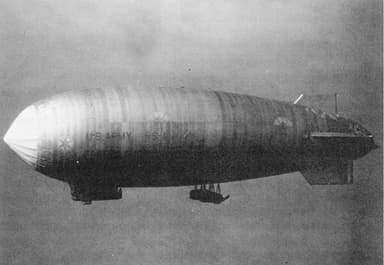
https://en.wikipedia.org/wiki/File:RS-1_Airship.jpg
Specifications were as follows:
- Length 282 ft, diameter 70 ft, volume 720,000 cu ft
- Four Liberty 300 hp engines, cruise speed 45 mph, top speed 75 mph
- Bombing cockpit, two forward machine gun mounts, three 500 lb bombs
RS-1 first flew on January 8, 1926 with a crew of eight in the enclosed control car suspended from keel to nose. The flight was successful and lasted one hour. She continued to perform satisfactorily. However, she was scrapped in 1930 after the need for a new envelope grounded the ship.
Meanwhile Russia Continued With Its Airship Program
Russia experimented with military balloons throughout this period. Most of the details are lost although some information has surfaced. It apparently built a series of hydrogen airships beginning in 1920 and continuing into World War II. These were likely of the non-rigid type, and identified by the prefix СССР-B.
Historian Mark Kulikowski describes how the Soviet airship program was bedeviled in the 1930’s by ‘technology and politics’. It never managed to completely catch up with the West, despite believing ‘sheer revolutionary enthusiasm and ideology’ would achieve this.

https://www.rbth.com/history/328419-why-didnt-soviet-airships-bomb
However, sheer gut and determination did show through in the end, this despite a lack of materials and skills. By the 1930’s Russia had moved on from cobbling old airships together, and started absorbing new western technology.
This was however still with a view to peaceful use. Larger, non-rigid airships such as V-1, V-2, V-3 and V-4 were designed for fighting forest fires, and tracing and eliminating sources of malaria. They were also well-suited for surveying large tracts of land for example Siberia.
Old Interest in Dirigibles Stirs in Europe
America escaped the ravages of World War I on home soil, and its interest in military airships continued unabated. However, it was going to take as much as a decade before Europe had time for them again. But Italian Umberto Nobile was determined to apply what he learned as an airship designer during the war.
Umberto was an aviator / aeronautical engineer who became an Arctic explorer. He was obsessed by the thought of medium-sized, semi-rigid airships crossing the Atlantic.
He formed the Aeronautical Construction Factory in partnership with Giuseppe Valle, Benedetto Croce and Celestino Usuelli, and they produced the airship T-24 AKA Roma in 1919. But they sold it to the U.S. Army after the British beat them to the first crossing in their R-34 dirigible.
Roma was duly dismantled and shipped in crates to the United States. The first flights were successful with only minor defects. Then on February 21, 1922 her box rudder failed as she was arriving in Norfolk Virginia. She collided with high power lines and crashed spectacularly in a ball of flame..
Umberto Nobile moved to the United States for a while, where he consulted with Goodyear until returning to begin work on his next project airship N-1. During this time he faced stiff opposition from entrenched Italian interests, as well as the chief of the air force general staff who was more interested in fixed wing aircraft.
An unusual opportunity distracted Umberto after Norwegian explorer Roald Amundsen contacted him. He wanted to fly to the North Pole in an airship, and he wanted Umberto to be his captain!
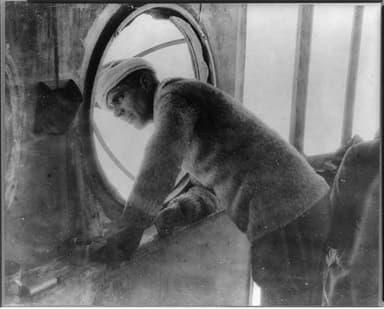
https://en.wikipedia.org/wiki/File:Umberto_Nobile_1.jpg
Umberto Nobile persuaded the Italian Airship Factory building N-1 to make it available for the expedition by March 29, 2016, after retrofitting it for Arctic conditions. The factory reinforced the vessel with metal frames at the nose and tail, and covered the flexible tubular metal keel with fabric creating space for storage and crew.
Her specifications were as follows:
- Length 347 ft, diameter 26 ft, payload 20,900 lb, volume 670,000 cu ft
- Propulsion 3 Maybach Mb.IV 260 hp, 6-cyl. water-cooled piston engines
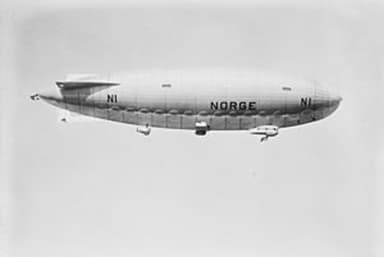
https://en.wikipedia.org/wiki/File:Norge_airship_in_flight_1926.jpg
The Norge, as Nobile called her, lifted off from Campino Airport in Rome on March 29, 1926. She set a course via England and Oslo to Gatchina near Leningrad, where she landed on April 15 after an 18 day flight. Norge remained in the airship shed for a week of maintenance and installation of collapsible rubber boats.
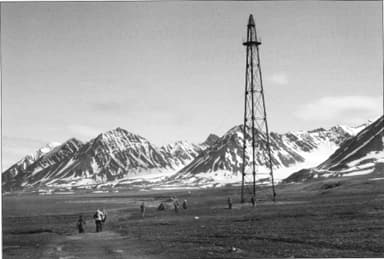
https://journals.openedition.org/teoros/402
There was a further week delay while they waited for completion of the mast and shed at Spitsbergen. Norge lifted off again on May 5, 1926, heading for Ny-Ålesund, Svalbard 1,288 miles away. They arrived at the Norwegian archipelago midway between continental Norway and the North Pole.
On May 11, 1926 Umberto Nobile, Roald Amundsen and a mixed crew of 14 Polar explorers and technicians headed out on a journey across the arctic ice. They reached the North Pole one day later, where they dropped Norwegian, American and Italian flags.
They landed in Teller, Alaska two days later after encountering strong winds. The trip was a great success and was probably the first journey to cross the North Pole. However, this came at the cost of Nobile’s and Amundsen’s friendship, for they quarrelled endlessly over who deserved the credit.

http://transpressnz.blogspot.com/2012/07/the-1926-flight-of-norge-airship-over.html
But Umberto Nobile was done yet. He was apparently infuriated by American Richard Byrd’s subsequently discredited claims to have beaten him to the Pole in a Fokker F-V11 tri-motor airplane with overhead wings.
Nobile commissioned an almost identical airship he named Italia during 1927 – 1928. He took to the air on April 15, 1928 from an airbase in Milan, and headed for the Arctic with 3 scientists, a journalist, 13 crewmen, and his dog on board. The crew roles provide insight into what was involved in flying dirigibles.
- 1 foreman / rigger / helmsman
- 2 navigators, 1 navigator, hydrographer
- 3 elevator operators, 2 radio operators
- 1 chief mechanic, 3 engine mechanics
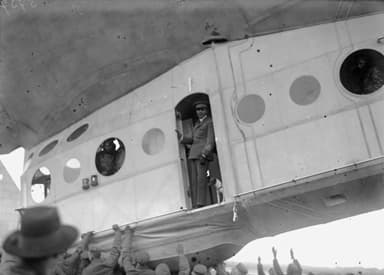
https://en.wikipedia.org/wiki/File:Bundesarchiv_Bild_102-05737,_Stolp,_Landung_des_Nordpol-Luftschiffes_%22Italia%22.jpg
Italia took 30 hours to reach Germany after passing through bad weather and encountering strong winds and a severe storm. The crew discovered hail damage to the propellers and envelope, and severe wind damage to the tail fin after she tethered in Stolp, Poland with her fuel almost exhausted.
Repairs took two days, after which bad weather caused further delays. Italia finally took to the air again on May 3, 1928. They passed over Stockholm before winds forced them towards Finland where they tethered at Vadsø. The crew spent an anxious night listening to the blizzard buffeting their airship.
They arrived at their base station, Ny-Ålesund on the island of Spitsbergen in Svalbard, Norway on May 5, 1928, and reunited with their support ship Città di Milano 2,325 miles from Milan.
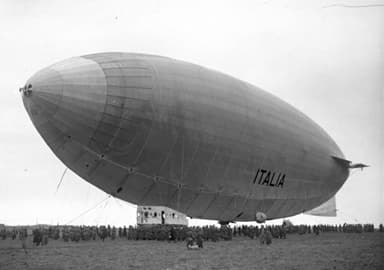
https://en.wikipedia.org/wiki/File:Bundesarchiv_Bild_102-05738,_Stolp,_Landung_des_Nordpol-Luftschiffes_%22Italia%22_(cropped).jpg
Umberto Nobile planned three flights over the Arctic after pausing for maintenance and repairs. He reached the North Pole during the third trip on May 23, 1928, where he dropped national and religious symbols.
His luck turned after that, as he attempted to return to Ny-Ålesund and encountered strong headwinds. Ice formed on the propellers in the fog, before coming loose and damaging the fabric without puncturing the hydrogen gas bags.
The rear rudder became jammed in the downward position, and eventually Italia slammed down on the ice pack despite valiant efforts. The envelope tore loose from the control cabin and drifted away together with half the crew and one wall, and was never seen again.
The survivors were rescued after 48 days surviving on supplies chief engine mechanic Ettore Arduino threw down to them from the hapless balloon, in an extraordinary act of valor.

The dirigible had once again shown its inherent weaknesses. Its vast bulk did not cope well with adverse conditions, and it had too much drag in strong winds. It also lacked sufficient power to get out of difficulties when disaster struck. Yet its days were not over, indeed its golden age was about to begin.
The Return and Resurgence of German Zeppelins

https://commons.wikimedia.org/w/index.php?search=los+angeles+airship&title=Special:Search&go=Go&ns0=1&ns6=1&ns12=1&ns14=1&ns100=1&ns106=1#/media/File:Uss_los_angeles_airship_over_Manhattan.jpg
The American decision to claim Zeppelin LZ-126 as war reparations from the Germans brought prestige to the U.S. Navy. But its manufacturer was the eventual winner because it operated successfully for eight years before retiring gracefully.
The Zeppelin company had reclaimed its lead in rigid airships. But it was not really back in business until the Locarno Treaties lifted restrictions on airship construction and the golden age of airships could begin.

https://en.wikipedia.org/wiki/File:Bundesarchiv_Bild_102-00834,_Friedrichshafen,_Luftschiff_Graf_Zeppelin.jpg
A new dirigible, Graf Zeppelin took to the skies on September 18, 1928 in honor of the company’s founder Ferdinand Adolf Heinrich August Graf von Zeppelin. She surpassed what went before her with these impressive specifications:
- Length: 775 ft, diameter 100 ft, volume 26,600,000 cub ft
- Load capacity: 43,900 lb, 20 passengers, 36 crew
- Power 5 × Maybach 550 hp V-12 reversible piston engines
- Output: Maximum speed 79 mph, range 6,200 miles
Graf Zeppelin commenced her journeys vertically using static lift, before starting engines to obtain aerodynamic lift. She approached her tethering tower slightly nose down, descending gently while adjusting trim, until reverse-thrusting to a halt and dropping her ropes.
Thereafter, upwards of 300 people manhandled the giant vessel into a hangar, or secured it by the nose to a tethering mast.
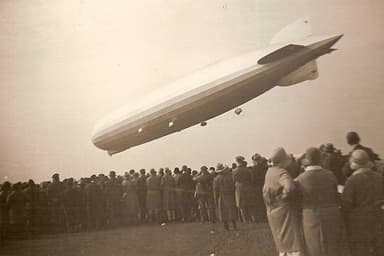
https://en.wikipedia.org/wiki/File:ZeppelinLZ127a.jpg
The passengers may well have been impressed by these superlatives, but they were surely pleased with their accommodation. They shared a gondola in the forward part of the ship with operational and common areas. The galley served three hot meals a day in an art deco dining room.
During the day they enjoyed the scenery. In the evening they danced to music playing on a gramophone, or sipped fine wines while an officer played a piano accordion. The crew were nowhere to be seen after they climbed a ladder to their accommodation above in the dirigible’s keel space.
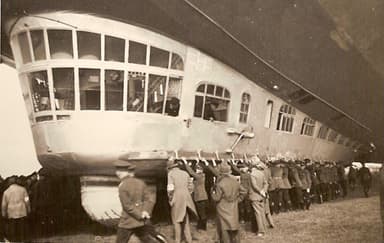
https://en.wikipedia.org/wiki/File:ZeppelinLZ127b.jpg

https://en.wikipedia.org/wiki/File:LZ_127_Graf_Zeppelin_Gondola_Plan.jpg
Graf Zeppelin predicted modern flight with her airplane-like layout of the forward gondola. She made intercontinental flights across the Atlantic, visited Europe, the Mediterranean, and the Middle East, and flew around the world in 12 days, 12 hours, and 13 minutes.
She visited South America, and rendezvoused with a Soviet icebreaker with Italian polar explorer Umberto Nobile on board. She withdrew from service after the Hindenburg disaster, having travelled just over one million miles. Herman Goring scrapped her to provide materials for German military aircraft.
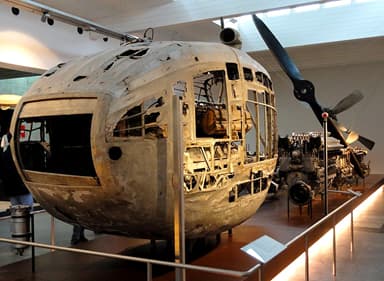
https://en.wikipedia.org/wiki/File:LZ_127_Graf_Zeppelin_port_engine_car_-_Zeppelin_Museum_Friedrichshafen_-_DSC06812.jpg
This time, the dirigible had shown its true worth. A graceful, leisurely way of traveling, as opposed to getting from one point to another as fast as possible. The world would not see the like of this luxury in air again, for a very long time.
The British Imperial Airship Scheme
Britain mulled over a dominion-wide airship service for almost a decade before formulating its plans. This was partly due to the spectacular failure of R-38, which it sold to the United States in 1919 before completion. But which broke up spectacularly while still in pre-delivery trials.
Britain decided to restart the new program with two airships, to be named R100 and R101. The first of these, R100 would be designed and built by a specially established Vickers subsidiary.
While the second, R101 would be managed by the Government’s Royal Airship Works at Cardington in Bedfordshire. The hangars still stood that housed wartime airships R-31 and R-32, but they would need extending for the new project.
R100 and R101 had distinct similarities, and differences. The technical specifications would be similar but the approaches would be different. The Vickers R100 was to follow existing technology. While the government-inspired one would act as a testbed for new innovative techniques, without government interference.
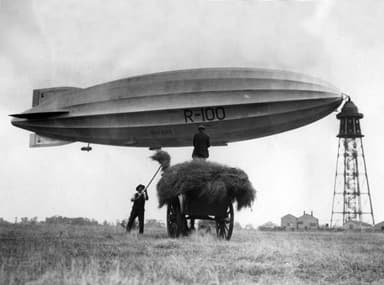
https://en.wikipedia.org/wiki/File:R-100_attached_to_mooring_mast_in_Bedforshire,_1930.jpg
R100 AIRSHIP DEVELOPED BY VICKERS
The original design work had commenced in 1925 but was beset with difficulties. Machine tools and labour were in short supply, especially because the project was a fixed price one.
Perhaps because of this the airship had only 16 longitudinal girders connecting 15 polygonal transverse frames. These frames were in turn held in position by wire bracing to a central longitudinal girder running the length of the ship.
The final specifications (at first flight) were:
- Length 719 ft, diameter 133 ft, volume 5,156,000 cu ft
- Crew 37, passengers 100, maximum speed 81 mph, range 4095 miles
- Propulsion 6 × Rolls-Royce Condor IIIB 12 cylinder, 650 hp engines

https://en.wikipedia.org/wiki/Rolls-Royce_Condor#/media/File:Rolls-Royce_Condor_III_RRHT_Derby.jpg
R100 performed well during tests, although the limited number of longitudinal frames caused the envelope fabric to flap. On January 27, 1930 she completed a 53 hour endurance flight from Cardington and back.
Perhaps her greatest triumph was her trip to Canada in July / August 1930 averaging 42 mph ground speed. She flew spectacularly over Niagara Falls and other landmarks. However, she never flew again after she returned to Cardington.

https://en.wikipedia.org/wiki/R100#/media/File:Airship_Toronto.jpg
A commentator wrote the team ‘guessed that their ship was a bad airship, but did not realise’ (because of secrecy at Cardington) ‘how bad the other ship was.’ Whatever the case, the engineers grounded her until the R101 tragedy.
Nonetheless, R100 represented the best conventional airship technology Britain had to offer at the time. In an act of ignominy they flattened her frame with steam rollers and sold the scrap.
R101 AIRSHIP DEVELOPED BY ROYAL AIRSHIP WORKS
R100’s sister airship was slightly longer at 721 feet. It held the record for the world’s largest flying craft until Hindenburg claimed the prize. Both Hindenburg and R101 used flammable hydrogen gas as their lifting medium. And both met fiery ends effectively ending hydrogen passenger travel, perhaps forever.
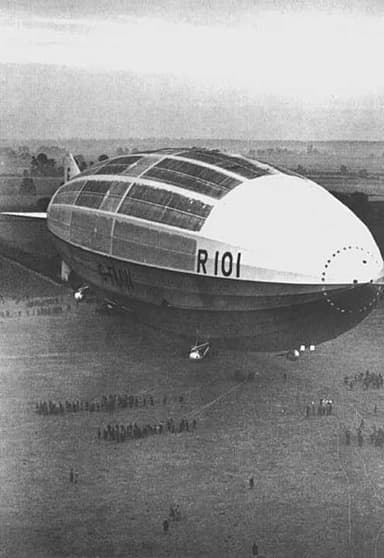
https://en.wikipedia.org/wiki/File:R101.jpg
The specification for R101 included:
- A crew of approximately 40, 100 passengers, fuel, stores, and water ballast
- Cruising speed 63 mph, maximum speed 70 mph, cruising range 57 hours
- Capacity for 200 troops in wartime, or possibly five parasite fighter aircraft
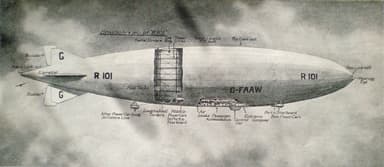
https://99percentinvisible.org/episode/airships-future-never/
The design brief included deliberately extending the limits of existing technology. The design of the frame was similar to R100, except the material was stainless steel. Vents in the tail and nose allowed air to enter while descending. While the vents in the circumference allowed it to exit when gaining height.
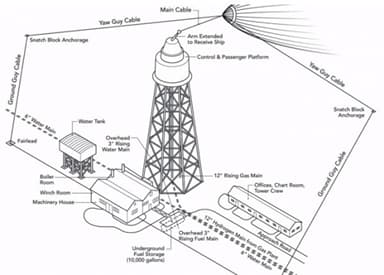
https://99percentinvisible.org/episode/airships-future-never/
The original design brief called for seven Beardmore Typhoon six-cylinder heavy-oil engines. However, when these proved underpowered a switch was made to eight-cylinder ones which were two four-cylinder motors cobbled together. These turned out to be overweight and the specification reduced to five.

https://en.wikipedia.org/wiki/File:Beardmore_Tornado_diesel_engine_from_R101.JPG
Each engine car had a 40 hp Ricardo petrol engine for self-starting. Three also had generators to provide electricity when R101 was moving slowly, or stationery. The duty officer on watch manned the control car, while engineers controlled the motors in response to telegraph orders.
Passenger accommodation spread across two decks. It included 50 cabins, a dining room, two promenade decks with windows, a spacious lounge, and two asbestos-lined smoking rooms. Weight saving measures included wicker chairs, aluminum cutlery, and cellulose-acetate windows.
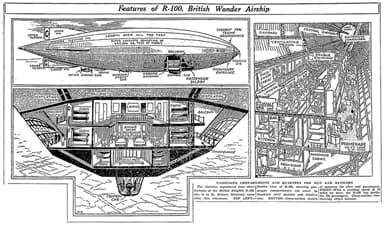
https://www.flickr.com/photos/ausdew/50217332347/
The giant airship attracted much interest, with over a million people traveling to view it tethered to the mast. R101 lifted into the air for the first time on October 14, 1929. She proved to be tail heavy, but easy to control.
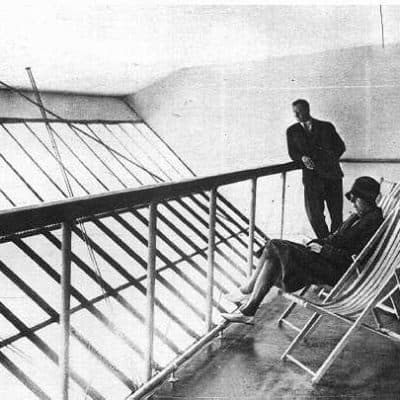
https://99percentinvisible.org/episode/airships-future-never/
However, the hydrogen gas bags surged in stormy weather, and holed in several places. The project team decided to lengthen the airship by one bay to improve buoyancy, and reduced weight in other areas. Several successful flights followed.
After she achieved her Certificate of Airworthiness, R101 set off for her first extended flight, to Karachi, India on October 4, 1930. One engine failed before she reached the channel. The weather turned foul. By the time they crossed into France she was ‘flying heavy’ necessitating shedding ballast.

https://commons.wikimedia.org/wiki/File:R101-crash_diagram.png
The giant airship went into a dive from 1,000 feet, recovered and entered a second one. An order was given to reduce speed. R101 hit the ground at an estimated impact of 13 mph, and immediately caught fire. 46 of 54 crew and passengers died instantly. The final toll was 48.
The inquiry concluded a rip developed in the forward fabric, causing one or more gas bags to fail. This would have made R101 too heavy to control with the elevators. The accident ended British interest in dirigibles during the pre-war period. They closed the doors on the hangars at Cardington and shut down the project.
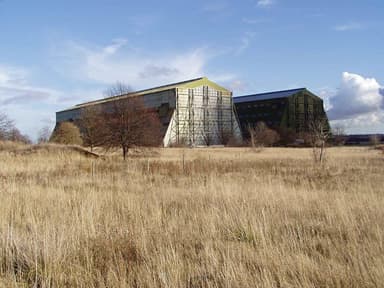
https://en.wikipedia.org/wiki/File:Cardington_2003.jpg
America Responds with USS Akron and Macon
The U.S. military were sufficiently pleased with the performance of the Zeppelin dirigible USS Los Angeles – and the semi rigid RS-1 Goodyear built – to order two new rigid airships. The first, USS Akron, launched August 8, 1931 and became the first purpose-built flying aircraft carrier able to launch and recover small aircraft.
The specifications of the helium-filled vessel were as follows:
- Length 785 ft, beam 133 ft, displacement 7,401,260 cu ft
- Power 8 × Maybach 560 hp V-12 reversible piston engines
- Maximum speed 79 mph, range 5,940 miles

https://en.wikipedia.org/wiki/Maybach_VL_II#/media/File:Bundesarchiv_Bild_102-07783,_Maybach-Zeppelin-Motor.jpg
The dirigible framework was constructed with the new, lightweight alloy duralumin 17-SRT. The main rings were self-supporting doing away with radial wire bracing. This would help avoid in-flight breakup as happened with R38/ZR-2 and ZR-1 Shenandoah, and create space for the hangar.
This in turn made it possible to cantilever the fins on the outside of the vessel, as opposed to the Zeppelin method which used internal cruciform supports. Three keels ran the length of the ship, providing walkways along the top of the hull and along each side.
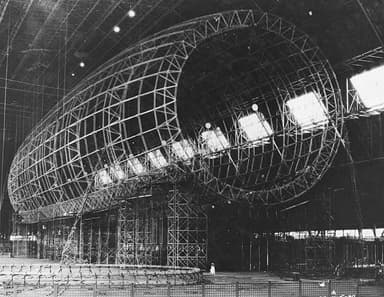
https://en.wikipedia.org/wiki/File:USS_Akron_under_construction,_nov_1930.jpg
An airplane hangar and trapeze system were at the heart and purpose of the giant dirigible. USS Akron could accommodate three F9C Sparrow Hawk fighter airplanes, plus a fourth one on the trapeze system. They were the best available scouting aircraft, although not built for the purpose.
The Sparrow Hawk pilot climbed on board their airplane, and started the engines before the trapeze lowered them through a trapdoor in the floor into the slipstream. The pilot then released the hook, and took over as the aircraft fell away from the airship.
The pilot positioned the aircraft beneath the trapeze upon returning, and ‘flew’ the skyhook into position until it latched on securely. They then idled the engine and signaled the trapeze operator to recover them. And then place them on a monorail trolley to take them to their storage bay.

https://en.wikipedia.org/wiki/File:F9C_in_USS_Akron_hangar1932.jpg
USS Akron launched on November 2, 1931 and completed four test flights. Thereafter she entered service with results better than land-based operations. She experienced several accidents during this time, necessitating grounding for repairs before rejoining fleet operations again.
On April 3, 1933 USS Akron cast off from the New England coast to continue calibrating radio direction finder stations. She entered an extreme storm of violent updrafts and downdrafts. These interfered with her altitude readings and resulted in her nose pointing up as much as 23 degrees.
Her lower fin struck the water and was torn off by the force. She broke up rapidly and sank beneath the stormy Atlantic. The loss of 73 crew out of 76 – including a rear admiral – spelled the beginning of the end of the rigid airship in the U.S. Navy.

https://en.wikipedia.org/wiki/USS_Akron#/media/File:USS_Akron_in_flight,_nov_1931.jpg
USS MACON, SISTER AIRSHIP
Akron’s sister ship, USS Macon launched on March 11, 1933 a month before Akron was lost. The two were among the largest flying objects in the world and still hold this record for helium-filled rigid airships.
Her propellers could rotate up and down, and back and forth to control the ship during takeoff or landing in an early form of thrust vectoring. Slots above the motors drew moisture vapor from engine exhaust gases. This was condensed into water, and used to compensate for weight loss as fuel was consumed.
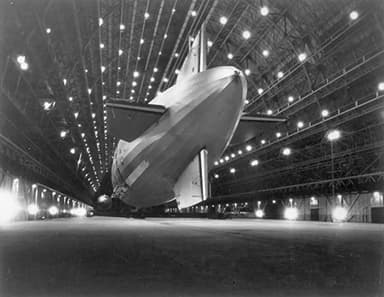
https://en.wikipedia.org/wiki/File:USS_Macon_at_Hangar_One.jpg
The wife of the rear admiral who died on USS Akron named USS Macon after the city in Georgia. Thereafter, the giant dirigible had a more productive career as her crew honed their skills scouting with airplanes for ‘enemy ships’ during exercises.
New scouting aircraft arrived in 1934. These were Waco UBF XJW-1 biplanes equipped with skyhooks and with a flying range of 400 miles. Then in April 1934, USS Macon flew into trouble crossing mountains in Arizona. She had to increase altitude to 6,000 feet which was twice her design maximum.
The resultant pressure-differential necessitated venting large amounts of helium to prevent her cells from leaking or rupturing. The crew dumped 9,000 pounds of ballast, and 7,000 pounds of fuel to compensate. However, Macon was still 15,000 pounds overweight and had to fly on full power to maintain sufficient dynamic lift.
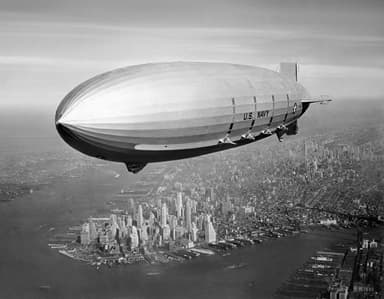
https://en.wikipedia.org/wiki/File:NH43901-enhanced.jpg
After that, a diagonal girder in a ring that supported the forward fin attachments snapped during a severe drop. However, the crew was able to take emergency action enabling her to limp home for repairs.
But even those were a stop gap, because they failed to deflate helium bags preventing access to girders on either side of the forward fin attachments. USS Macon returned to service even though the repairs were incomplete. On February 12, 1935 she ran into a storm off Point Sur, California.

https://en.wikipedia.org/wiki/File:Macon_construction_struct.jpg
An upward wind shear caused the ring supporting the upper tailfin to fail. The debris punctured the rear gas cells. Confused by a lack of information, the commander ordered an immediate, massive discharge of ballast. They lost control with engines running on full as the dirigible rose rapidly back to 4,850 feet requiring helium discharge to steady her.
An emergency message went out as USS Macon descended for 20 minutes, and sank gently into the sea. There were 81 survivors. Two of the crew died when they broke discipline and behaved rashly. An officer in the rescue flotilla wrote, ‘This may contradict with the papers, but this is straight. There was an explosion in the tail and they could not control it.’
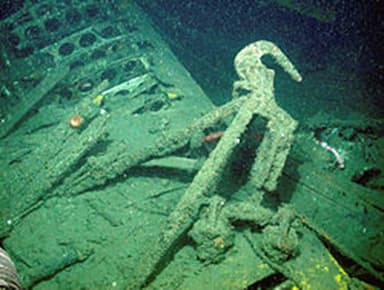
https://en.wikipedia.org/wiki/USS_Macon_(ZRS-5)#/media/File:Uss-macon-sparrowhawk-sky-hook-09-2006b.jpg
Russia’s Orders Designs from Umberto Nobile
Russia continued designing and building non-rigid hydrogen airships identified by the prefix СССР-B. However, it departed from this policy in the early 1930’s, when Umberto Nobile contributed semi-rigid designs including USSR-V5 and the SSSR-V6 OSOAVIAKhIM.
SSSR-V6 was the largest airship Russia built, and turned out the most successful. It established a new record for endurance in October 1937, beating Hindenburg with a time of over 130 hours. Her specifications were as follows:
- Dimensions: length 342 ft, width 60 ft, volume 685,105 cu ft
- Capacity: crew 15, lifting medium hydrogen, useful lift 21,253 lb
- Performance: cruising speed 64 mph, maximum range 2,980 mi
- Propulsion: 3 × straight six, 260 hp Maybach Mb.IVa engines
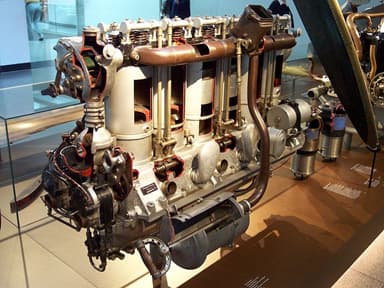
https://commons.wikimedia.org/wiki/File:Maybach_Mb_IVa.jpg
SSSR-V6 made her first flight on November 5, 1934. No details are to hand regarding her operational career. However, the media spotlight fell on her in February, 1938, when she set off to rescue a Soviet Arctic expedition stranded on pack ice.
She got into difficulty on February 6, 1938, when she crashed into the hillside near Kandalaksha, 140 miles south of Murmansk. She caught fire and was utterly destroyed, killing 13 of 19 people on board. The TASS news service ascribed the disaster to poor visibility and insufficient flight altitude.
Reinvestigation in 2017 suggested SSSR-V6 departed her planned route as the crew became disoriented in darkness and snowfall. Whatever the case, this was a severe blow to the Russian airship program, from which it never fully recovered.
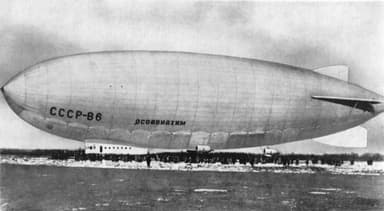
https://en.wikipedia.org/wiki/SSSR-V6_OSOAVIAKhIM#/media/File:W-6_Ossoaviachim_wiki.jpg
The End of an Era – LZ-129 Hindenburg
The loss of three military airships, Los Angeles, Akron and Macon put an end to large-scale dirigible activity in the United States, although a few intrepid entrepreneurs did experiment with passenger travel and air freight. The 1931 Empire State Building had a tethering mast on the roof, but there were no customers.
Despite this Germany soldiered on, inspired by its successful completion of LZ-127, Graf Zeppelin. By the 1930’s it was competing successfully with other means of civilian transport, because it accommodated more passengers than civilian aircraft.
Moreover, Graf Zeppelin was faster than ocean liners, while providing similar amenities on a smaller scale. However, airships were still labor-intensive with more crew than passengers, and hundreds more needed to assist with mooring, or storing in large, expensive hangers. As a result, the operation was still only approaching break-even.

https://en.wikipedia.org/wiki/Hugo_Eckener#/media/File:Bundesarchiv_Bild_102-00645,_Probefahrt_des_Zeppelin-Luftschiffes_Z.R._III.jpg
Hugo Eckener, now head of Zeppelin, had originally intended to build a bigger version of Graf Zeppelin, LZ-128. This would have 8 engines, be 761 ft long, and have a volume of 7,062,100 cu ft. However, the loss of British airship R101 on October 5, 1930 set this back.
Eckener abandoned the idea of a Graf Zeppelin II, in favor of something more ambitious. He began working on project LZ-129 which would become the Hindenburg named after a previous German president. He dreamed without success of filling it with inert helium which would not be subject to unwanted chemical reactions, including fires.
However, it was now 1933 and a Nazi government was in control. It wanted to use Zeppelins as propaganda tools, and absorb the company into Lufthansa. The government silenced Hugo Eckener’s objections, and from then on Zeppelins displayed swastikas on their tailfins.
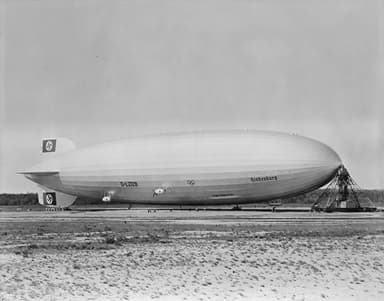
https://en.wikipedia.org/wiki/File:Hindenburg_at_lakehurst.jpg

Spruce Goose, Airbus A380-800, Boeing 748 Intercontinental, Antonov An-225 Mriya
https://en.wikipedia.org/wiki/File:Giant_Aircraft_Comparison.svg
The Hindenburg launched on May 16, 1937. She used flammable hydrogen for lifting medium, because the United States had embargoed the supply of non-flammable helium. She shared the transatlantic service with sister airship Graf Zeppelin, when not diverted on flag-flying missions.
The statistics of the largest airship ever built were as follows:
- Dimensions: length 803 ft, diameter 131 ft, volume, 7,062,000 cu ft
- Propulsion: 4 × Daimler-Benz DB 602 V-16 1200 hp diesel engines
- Capacity: 50 – 70 passengers, 40 – 61 crew, top speed 85 mph, range 8,700 miles
However, the sheer opulence of her passenger accommodation was the star attraction, for it compared well with transatlantic passenger liners, but she flew faster.
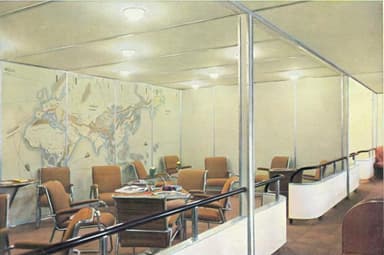
https://en.wikipedia.org/wiki/File:Bundesarchiv_Bild_147-0639,_Luftschiff_Hindenburg_(LZ-129),_Gesellschaftsraum.jpg
Hindenburg entered transatlantic service after a period of testing, and making propaganda flights around Germany. She completed 17 round trips during 1936, and opened the 1937 season with a South American flight. Then, on May 3, 1937 she left Frankfurt for Lakehurst New Jersey, arriving three days later at 7pm after encountering buffeting winds.
Hydrogen gas may have been leaking from the aft portion of Hindenburg as she approached the tethering post. Apparently she released water ballast from the rear, and sent six crew members to the bow to keep the craft level.
A fire erupted in the tail of the ship as she was landing. Within seconds, the entire vessel was on fire from stem to stern. Miraculously, only 35 of 97 people on board perished, plus one person on the ground. An investigation concluded static electricity ignited hydrogen leaking from gasbags, although there were also allegations of sabotage.

https://en.wikipedia.org/wiki/File:Hindenburg_burning.jpg
Immediately Prior to WW2 – The Second Graf Zeppelin
The dirigible movement was in tatters following the loss of Hindenburg. This followed on airship disasters in other nations in the forefront of lighter-than-air flight. There would be no more passenger seats to fill, because there were no customers. However, Hugo Eckener at Zeppelin in Germany decided to have one more try.
He dusted off the plans for LZ 130, Graf Zeppelin II. She would prove to be a good airship, even though she was filled with flammable hydrogen on account of the United States helium embargo.
Her statistics on the drawing board were as follows, similar to Hindenburg:
- Dimensions: length 803 ft, diameter 135 ft, volume, 7,100,000 cu ft
- Propulsion: 4 × 1,200 hp Daimler-Benz DB 602 V-16 diesel engines
- Capacity: accommodation for 40 passengers, 40 crew
- Performance: top speed 84 mph, maximum range 8,900 miles

https://en.wikipedia.org/wiki/File:LZ130_Construction.jpg
LZ 130 made her first flight on September 14, 1938. She had assumed the name Graf Zeppelin in her license, because her namesake was ‘retired’ from the list. She had also changed her purpose during construction from passenger vessel to a laboratory for radio surveillance and measurements.
Thus the world would never see intended luxury even greater than Hindenburg. There would have been 20, even more luxurious cabins for her 40 passengers. Thirteen of these would have windows on the middle deck with the dining room above them, and the lounges and smoking rooms conveniently below.
The seven test flights were a great success. ‘Graf Zeppelin’ then departed on a show flight over occupied Czechoslovakia on behalf of the Reich Ministry for Public Enlightenment and Propaganda. Thereafter she continued installing and testing equipment for her new, para military purpose.

https://en.wikipedia.org/wiki/File:LZ_130_Graf_Zeppelin_II_at_Lowenthal_1938.jpg
Graf Zeppelin departed on her one and only espionage flight between August 2 and 4, 1938. She flew for over 48 hours off the English coast, covering a distance of 2,612 miles to collect information about the British chain home radar system. However, the trip failed to achieve its spying mission.
Three flights later the authorities grounded her on August 29, 1939, because they saw her as a ‘potential hazard with the imminent war’. On February 29, 1940 the German authorities began demolishing Graf Zeppelin, incomplete LZ 131, and their hangars to yield their metal for construction of fixed wing military aircraft.
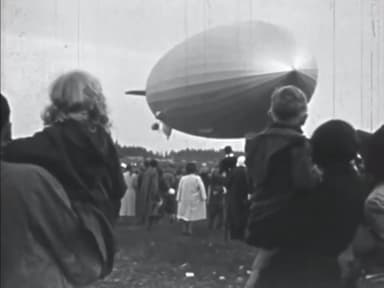
https://en.wikipedia.org/wiki/LZ_130_Graf_Zeppelin_II#/media/File:GrafZeppelin2NES.jpg









